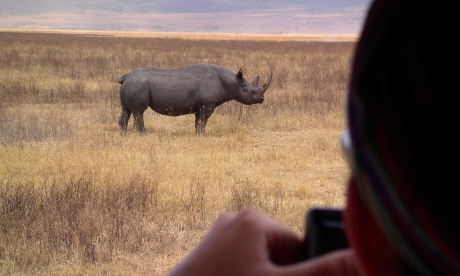
Wildlife expert Mark Carwardine makes a new friend in South Africa
I’ve just made friends with a remarkable 21-year-old rhino. We were in a valley of dense bushveld in South Africa’s Eastern Cape when Africa’s most famous black rhino, called Shibula, revealed an extremely well-kept secret.
Shibula was born in 1984 in the wilds of Namibia but was captured and shipped to Lisbon Zoo five years later. She was rescued in 1990 and taken to Augrabies Falls National Park in South Africa. Then, at the grand old age of ten, she mated with a wild bull and produced her first calf. It was a huge milestone in black rhino conservation.
Nowadays Shibula lives in Addo Elephant NP, safely tucked away in the farthest corner of the continent. I spent half a day with her, from just after dawn until the sun was directly overhead, in the Darlington section of Addo.
Despite her many encounters with humans – or perhaps because of them – she was far from tame. In fact, she was one of the most nervous black rhinos I’ve ever seen. A healthy fear of people is a good thing, of course, but it meant that she maintained a safe distance of at least 500m. She spent most of her time hiding behind a bush.
I’m glad I persevered, though, because eventually she came out into the open. And with her, scurrying along by her feet, was a brand new, minuscule calf. It was her sixth.
Shibula is the figurehead of a campaign to bring black rhinos back to Africa. During the 1970s and 80s, 96% of the population was slaughtered by poachers. There were estimated to be 65,000 in the wild in 1970; by 1995 only 2,410 remained. Conservation efforts during the past ten years have built the numbers back to a slightly healthier 3,600 and the vast majority of these live in South Africa and Namibia.
The long-term aim is to translocate as many as possible to neighbouring countries, and to East Africa, where they already have (or have had) native black rhino populations.
Addo Elephant NP was originally established to save Eastern Cape elephants from extinction and it has been extremely successful – the population has grown from a mere 11 elephants in 1931 to more than 420 today. Elephants are still the main attraction for visitors to the park, which is malaria-free and just an hour’s drive from the coastal city of Port Elizabeth. They have a wide area in which to roam and are sometimes hard to find, but plentiful dung confirms their existence and provides constant work for the unique flightless dung beetles that are virtually endemic to Addo.
In recent years the park’s emphasis has shifted to a much broader conservation effort. The current policy is to introduce animals, such as lions and spotted hyenas, that lived in the area historically but were wiped out by poaching or habitat encroachment.
Black rhinos, of course, are a vital ingredient in the plan to turn back time and return this delightful corner of the Eastern Cape to its original state as it was over a century ago.
The potential for the rhinos here is phenomenal because few places in Africa provide them with better habitat. All being well, today’s population of about 40 animals could grow to several hundred.
Meanwhile, Shibula continues to make her own remarkable contribution. Her second calf, a male called Swagger, died in 1996, but five calves survive. Local rangers, researchers and conservationists can hardly contain their excitement at the possibility that one day, maybe soon, she could become a grandmother.
Zoologist Mark Carwardine’s latest book is Extreme Nature. He presented Nature on BBC Radio 4 for many years. Check out his website here: www.markcarwardine.com